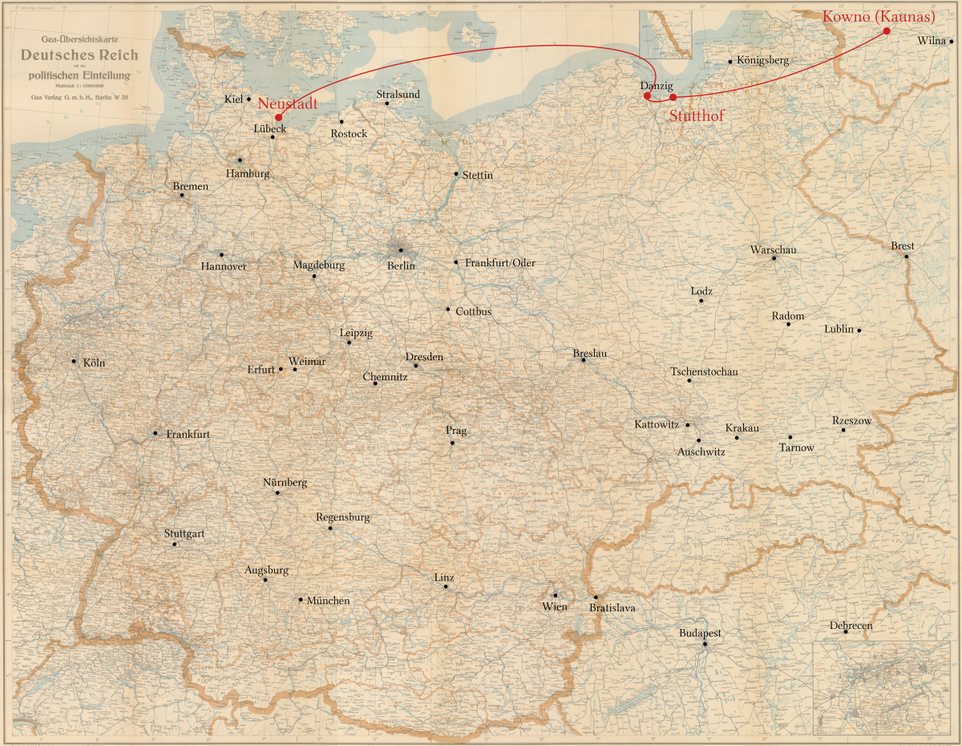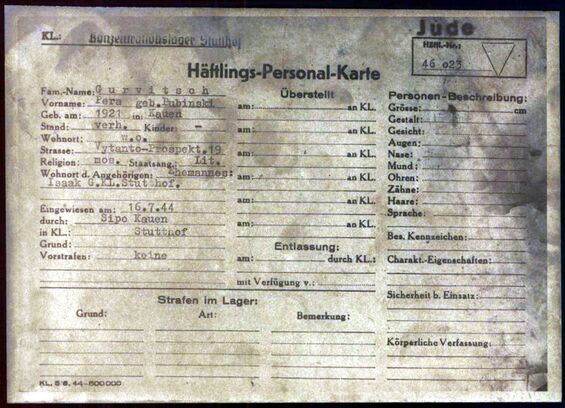The Biography of Pera Giner, Kaunas
Short biography and stations of her persecution
Pera Giner, née Dubinski, widowed Gurwitsch, born on 5.8.1921 in Kaunas/Lithuania
Parents: Noah Dubinski, Rachel Dubinski, née Finkelstein
- 1929/1930 Pre-school "Deutsche Ober-Realschule zu Kauen"
- 1933 Lithuanian grammar school
- 1940 A-levels
- 1940-1941 Employed by the company "Centrinis Vaistu Sandelis", first in the warehouse, then in administration
- June 1941 Kaunas ghetto
- 1.5.1942 Married Isaak Gurwitsch in the Kaunas ghetto
- Summer 1944 Stutthof concentration camp
- April 1945 Evacuation by sea
- May 1945 Liberation near Neustadt/Holstein
- 5.5.1945 Husband dies in Dachau
- End of 1945 to beginning of 1946 DPL Wedel near Hamburg
- Beginning of 1946 to end of 1946 DP Hostel Hamburg Alsterchaussee 34
- Late 1946 to May 1947 Blankenese, Flottbeckerchaussee 235
- May 1947 Emigration to Israel
Pera Giner lost her husband, mother, grandmother, uncle, aunts, and other family members during the persecution.
Pera Giner was 20 years old when her persecution began.
Family history
Her father's family, like her father, lived in Odessa until 1913, and her grandfather also resided in Königsberg (now Kaliningrad), East Prussia. He was a grain wholesaler and exporter. The family placed a high value on their father's university education in mechanical engineering in Germany. He was enrolled at the municipal Friedrichs-Polytechnikum in COETHEN/ANHALT on July 29, 1911. It was no longer possible to continue his studies after the war began, but her father remained in Germany and also met his future wife, Rachel Finkelstein from Kaunas/Lithuania, here. She had enjoyed dental training in Berlin at the Charite under Professor Williger. After the war, her father and his future wife went to Kaunas, where they married in 1920 and Pera Giner was born in 1921. The family belonged to the Baltic-German community, where, as in other parts of Germany, great importance was placed on a thorough knowledge of the German language and culture. German was spoken in the family, German literature was read and German newspapers were subscribed to.
Pera Giner was looked after by a Baltic-German, qualified kindergarten teacher at pre-school age, and later enrolled at the "German High School in Kaunas", which was later renamed the "German Gymnasium in Kaunas". She attended this school from the beginning of the 1928/1929 school year until the end of the 1932/33 school year. She then left the school in protest against the persecution of Jews in Germany and went on to attend the Lithuanian Gymnasium, which she left at the end of the 1939/40 school year with her Abitur (A-levels).
She then worked as an employee at a Lithuanian company until 1941 (for details, see the transcript of the affidavits of Pera Giner and her father).
Pera Giner file, Hamburg State Archives, signature 351-11_44679, Pera Giner file, Archive of the Munich Labor Movement e.V.
During the persecution, I lost my husband, my mother, grandmother, uncles, aunts and other family members and was only a human wreck when I was liberated after all I had suffered.
Akte Pera Giner, Archive of the Münchner Arbeiterbewegung e.V., Affidavit for application for compensation for "damage to body or health" dated 5/24/1964
Kaunas Ghetto
When the Germans occupied my hometown of Kaunas in June 1941, we Jews had to wear the yellow star of David on our chests and backs. At the beginning of August 1941, I was sent to the Kaunas ghetto. I was held there until the summer of 1944. The ghetto was secured by barbed wire and guarded by the SS. I was forced to do non-stop forced labor in the ghetto: cleaning and clearing work for the Waffen-SS, as a warehouse worker in a Wehrmacht camp, and as a transport worker on an airfield.
Source: Affidavit by Pera Giner regarding "damage to freedom" dated December 9, 1954, Hamburg State Archives, signature 351-11_44679
We were sent with Perla Dubinski, later Mrs. Gurwitsch and now Mrs. Pera Giner, to the Kovno Ghetto in August 1941, where we worked at the following workplaces: railroad maintenance, the Wehrmacht and the Waffen SS
Source: Affidavit of the witness Sonja Sudarsky dated October 9, 1953. Pera Giner file, Hamburg State Archives, signature 351-11_44679
Stutthof Concentration Camp
In the summer of 1944, I was taken to the Stutthof concentration camp. There I received the prisoner number 46022 and had to work as a clerk in the hospital there. I remained there until the end of April 1945, when the evacuation of the concentration camp began. We were loaded onto ships and liberated by British troops not far from Friedrichsort.
Source: Affidavit of Pera Giner, Hamburg State Archives, signature 351-11_44679
According to the Stutthoff concentration camp prisoner personnel file ("Häftlings-Personal-Karte"), Pera Gurwitsch was admitted to the Stutthof concentration camp on July 16, 1944.
Note: You can find a description of the situation during the journey to Neustadt in the biography of Zwi Zaks.
When the ghetto was liquidated in July 1944, we were deported to Germany together with the other Jews and Pera Giner. We were taken to the women's camp at Stutthof and were in the Stutthof central camp until April 1945. We were evacuated from Stutthof to Kiel, where we were liberated by the British at the end of April or beginning of May 1945.
Affidavit of Sonja Sudarsky dated October 9, 1953, Pera Giner file, Hamburg State Archives, signature 351-11_44679
Fate of Husband
Pera Gurwitsch's husband, Isaak Gurwitsch, was deported from Kaunas to Dachau and was admitted there on July 29, 1944. He received the prisoner number 85371 there. According to the entry, he died there shortly after the liberation on May 5, 1945. The decision for "damage to life" from January 30, 1961:
"1.) The applicant, as the surviving dependant of her husband Isaak Gurwitsch, born on 5.16.1908, died on 5.5.1945, [...] receives capital compensation for the period from 6.1.1945 to 10.31.1948 in the amount of 2,583.89 DM [...]
Reasons:
The applicant is the widow of Isaak Gurwitsch, born on May 16, 1908. He was sent to the Kovno ghetto in 1941 because of his Jewish descent. From there he was taken to the Dachau concentration camp in July 1944. He died there shortly after liberation on May 5, 1945."
Source: Pera Giner file, Hamburg State Archive, signature 351-11_44679
After Liberation
I was taken with the English troops, as an interpreter, to the former concentration camp Neuengamme and from there to the former ZAL Wedel near Hamburg. I came to Hamburg in the same capacity around May 1946, became an UNRRA Employee II class there and remained in Hamburg continuously until I emigrated to Israel at the beginning of May 1947. I emigrated legally on the basis of a certificate. I arrived in Israel on May 31, 1947.
Source: Affidavit of Pera Giner dated Dec. 9, 1954, Hamburg State Archives, Pera Giner file, signature 351-11_44679
... At the end of 1945, I was a DP inmate in the DP camp in Wedel near Hamburg, where I resided until early 1946. There I was employed as an interpreter by UNRRA and in this capacity I was transferred by UNRRA in 1946 to the DP Hostel Hamburg, Alsterchaussee 34, where I resided; at that time my place of From the end of 1946 – and beyond January 1947 – I lived continuously until the beginning of May 1947 in the suburb of Blankenese near Hamburg, at Flottbeckerchaussee 233 (the residence of UNRRA team 74).
At the beginning of May 1947, I emigrated to Israel, where I arrived on May 31 of the same year.
Source: Affidavit of Pera Giner dated May 17, 1957, Hamburg State Archives, Pera Giner file, signature



